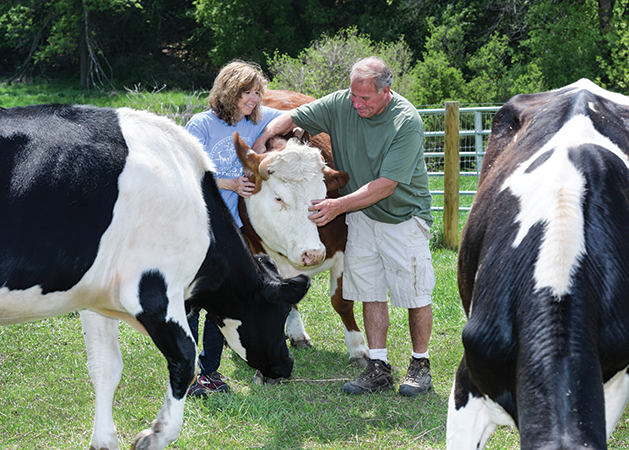
The animals at Long Lake’s Spring Farm Sanctuary look happy. But behind their loving eyes are heart-wrenching stories of past abuse, neglect and the horrors of factory farming. And that, according to the owners, is precisely the point.
The story of Libby the pig began with a Craigslist ad for $1 animals. When Robin Johnson and her partner Buck Weber answered it, their intention was to bring home two goats. What they found was a backyard butcher—and apparent animal hoarder—singeing hair off a dead pig while countless animals trod around him in hellish conditions.
The goats, Archie and Larry, came home that day. When Johnson’s eyes met those of the Chester white pig living in squalor in back, she knew she had to return. When they backed a borrowed livestock trailer up to the pen on the Fourth of July, the owner was hitting the pig with a board, swearing and threatening to shoot her. It took extensive surgery—plus weeks of recovery after large-animal vets at the University of Minnesota drained 100 pounds of pus from her uterus—but Libby eventually recovered.
Then there’s Buddy. Last fall, a woman called Johnson after she made her annual purchase of piglets for a farmer to fatten and slaughter for her. Her piglets escaped from the farm, and the farmer didn’t have time to find them. She went searching herself and found Buddy lying on top of his brother, who had frozen. She took Buddy home, planning to fatten him up herself so he could become next year’s bacon, and along the way got to know him. “She realized he had emotions. He enjoyed touch, voices, food and shelter,” says Johnson. Buddy’s life was saved.
Johnson is an entrepreneur who has owned a travel company, started a few nonprofits and recently sold a successful cupcake business. A longtime vegetarian, she came across the book The Lucky Ones by Brooklyn-based activist and factory farming opponent Jenny Brown. Johnson found her calling within the pages of that book.
She became vegan, sold her home, found land in Long Lake and started building a 27-acre farm animal sanctuary. Spring Farm Sanctuary (SFS) officially opened last July and is now home to 18 rescued farm animals like Libby and Buddy.
“But I could have hundreds. I get calls all the time,” Johnson says. “One woman found a stray chicken wandering around town. People buy potbelly pigs—but they get big and smelly, and then people want to get rid of them.” The idea isn’t just to give a better life to a handful of local animals—although she and her team of volunteers make certain of that. It’s also to raise awareness of the endearing personalities of animals and educate visitors on the injustices of factory farming, as well as the environmental and nutritional merits of a plant-based diet.
Public tours happen weekly during the warmer months, and visitors hear the specific stories behind SFS’s residents—and also the conditions animals like them endure in factory farms across America.
“These are intelligent, sentient beings that don’t deserve a life of abuse they often have,” says Johnson. “I think society will look back at this someday—at all the horrendous things we do to beautiful animals—and wonder what in the world we were thinking.”
The Stats on Factory Farming
70: Percentage of the Amazon rainforest converted into grazing land to keep up with demand for meat.
110,000: Number of fish killed when an open-air animal waste lagoon spilled in Illinois in 2011.
250: Average annual egg production of a factory hen—compared to 80-150 a century ago—due to selective breeding and added hormones.
5-6 months: Age at which a male pig is slaughtered for meat. They’re taken from their mother hours after birth and castrated, their tails cut off without anesthesia—and then they’re fattened as quickly as possible.
7 months: Average age at which a factory sow is first artificially impregnated. “Then they’re kept pregnant or nursing their entire life in tiny gestation crates where they can’t even turn around to see their piglets,” says Johnson. “They literally go nuts. They chew even though there’s nothing in their mouth. It’s not a good life.”
Get Involved
Giving rescued farm animals a safe, comfortable place to live out their remaining years is one of the goals of Spring Farm Sanctuary. Another is to inspire change through education. Here are some of the team’s suggestions for making a difference.
Change your diet.
Some people have become vegetarian or vegan because of a visit to Spring Farm Sanctuary. Another option is to cut back on your meat and animal-derived food consumption: waste less, increase the ratio of plant-based foods you’re consuming or simply opt out of meat more often. Meatless Monday, maybe?
Take a tour.
Get to know an animal face-to-face on one of the tours offered Saturdays, May–October, at Spring Farm. “We go pen to pen, story to story. People give the animals treats and look them in the eye,” says Johnson. “Paul McCartney famously said, ‘If slaughterhouses had glass walls, we’d all be vegetarians.’ For a lot of people, it’s the first time they’ve ever been eye-to-eye with a cow. Sometimes, it’s just ‘out of sight, out of mind.’”
Support the farm.
Spring Farm Sanctuary is a donor-supported 501(c)3 organization. Give a one-time gift or sponsor a specific animal. Volunteer to clean pens or give tours. Put your Amazon Prime account to good use by sending a few items from the farm’s online wish list, or donate produce. “We give fresh fruits and veggies every day,” Johnson says. “They love the good stuff.”









